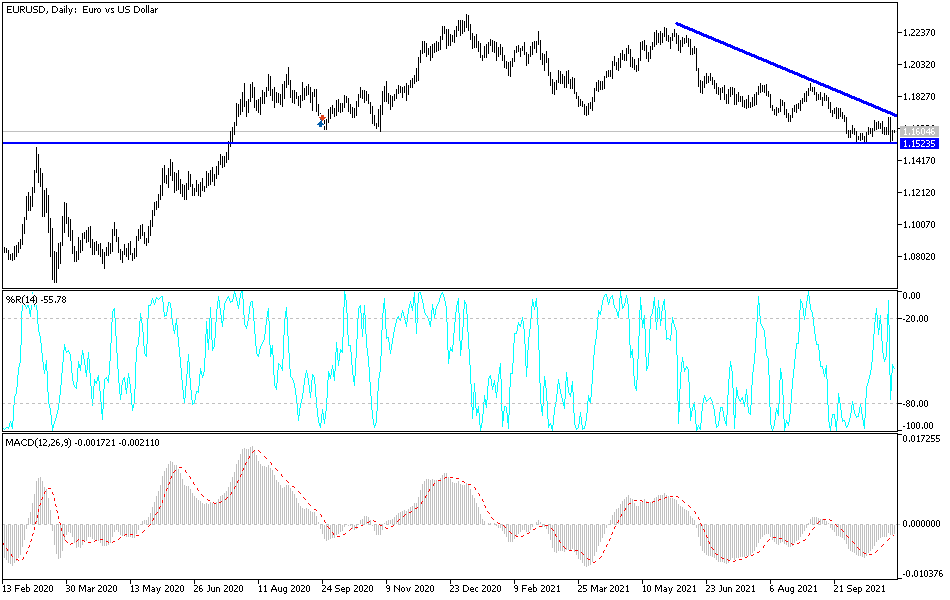The EUR/USD picked up where it left off last week and settled below the 1.1600 level. This performance came amid strong expectations that the Federal Reserve will announce this week about reducing its purchases of bonds. The euro will be affected today by the announcement of the Manufacturing PMI readings for the Eurozone economies.
The euro price may be on course to retest the 2021 low against the dollar, although the end of the week may depend on the outcome of the Fed's policy update on November 3. The strong losses of the currency pair were due to a significant rise in the price of the US dollar, which rose against the other major currencies. In response to some strong US data, the euro's biggest one-day drop against the dollar since June triggered a major technical failure that heralds further weakness in the near term.
“Below the 1.1522 support lies the 50% retracement of the move from 2020 and the March 2020 high at 1.1492/95, the main support is the previous downtrend (from 2008) which is now at 1.1366,” says Karen Jones, Head of Technical Analysis Research at Commerzbank. .
Commerzbank's technical analysis team holds a bias for EUR/USD weakness in both the short-term and long-term time frames, saying that only a move above the resistance line at 1.1701 will ease the immediate downside pressure and allow for a retest of 1.1909 and 1.1906, the 200-day moving average. They say that the short-term (1-3 weeks) trend is negative as is the long-term (6-9 months) trend, which can extend to 1.1366.
Therefore, technical considerations on the market are likely to influence a major decision by the Fed, at 18:00 GMT on Wednesday 3rd November, which will be the most important event in the calendar for the EUR/USD exchange rate.
The Fed has indicated for some time that it is ready to reduce stimulus now that the economic recovery looks strong and inflation pressures are starting to rise significantly. Economists are looking for the Fed to reduce its monthly asset purchases by $15 billion starting in November, with $10 billion coming from Treasuries and $5 billion in mortgage-backed securities.
A move to reduce the size of quantitative easing may be a necessary first step before raising the US interest rate in 2022. It can be argued that the timing of this first hike - and the number of increases that can be jammed in 2022 and 2023 - will have the greatest impact on the market in the future.
Therefore, it is guidance on future policy rather than an actual decision to reduce quantitative easing that will be important for the dollar in the middle of this week's trading.
Many analysts are of the view that markets have already "tapered" pricing that the Fed is still likely to lag behind other G10 global central banks in terms of rate hikes due to its tolerable inflation framework. I recall that the Fed is now targeting labor market dynamics as well as inflation, while the likes of the Bank of England are explicitly directed at ensuring price stability.
Technical Analysis
No change in the movement, no change in expectations. The EUR/USD currency pair returned to its broader bearish trend, and on the daily chart, the breach of the 1.1525 support, which it is close tonow, will give the bears the impetus for heavier bearish breakdowns. The closest levels after that will be 1.1445 and 1.1350, which are sufficient levels to push the technical indicators towards strong oversold levels. On the upside, the bulls will move towards the 1.1700 and 1.1850 resistance levels to bring about a real and strong reversal of the general trend, which is still bearish.


